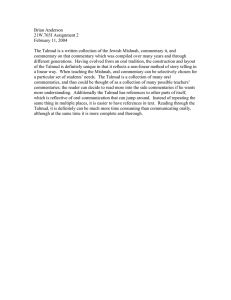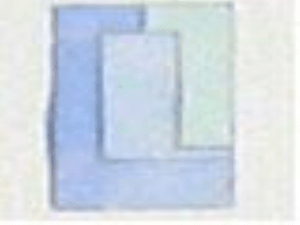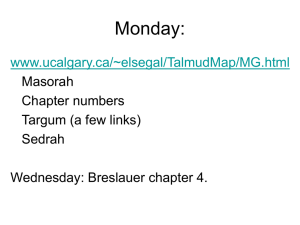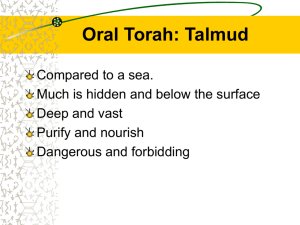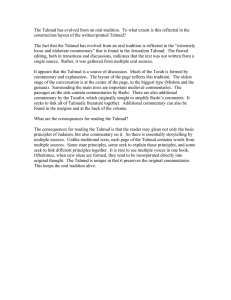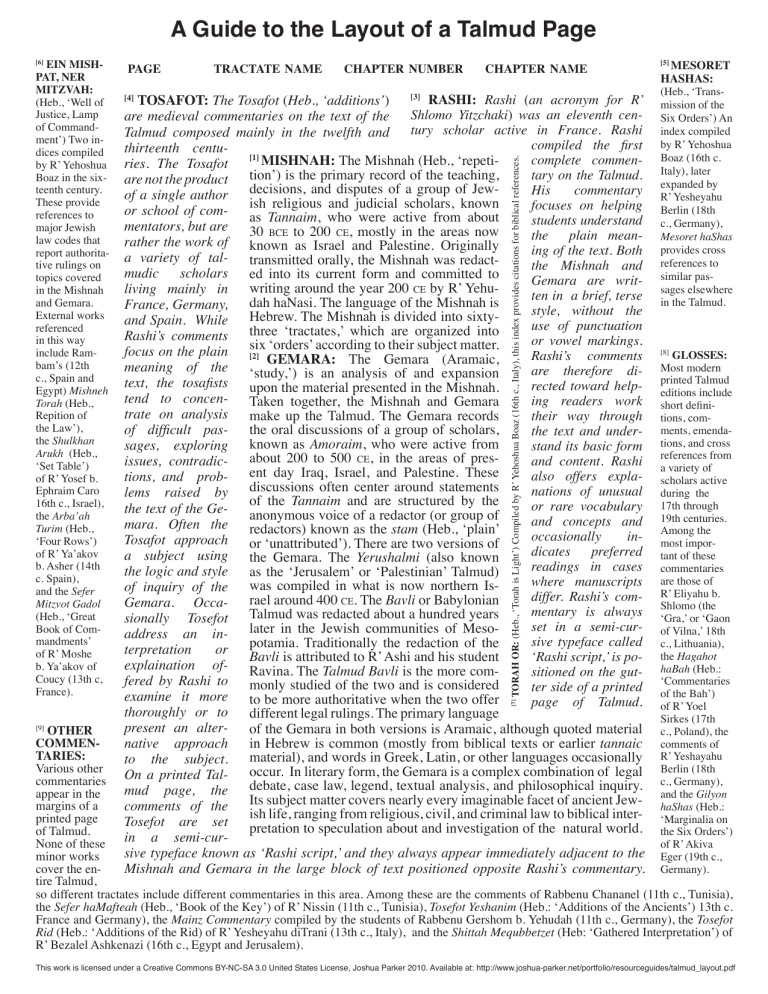
A Guide to the Layout of a Talmud Page page tractate name chapter number chapter name [3] RASHI: Rashi (an acronym for R’ TOSAFOT: The Tosafot (Heb., ‘additions’) Shlomo Yitzchaki) was an eleventh cenare medieval commentaries on the text of the tury scholar active in France. Rashi Talmud composed mainly in the twelfth and compiled the first thirteenth centu[1] complete commenMISHNAH: The Mishnah (Heb., ‘repetiries. The Tosafot tion’) is the primary record of the teaching, tary on the Talmud. are not the product decisions, and disputes of a group of JewHis commentary of a single author ish religious and judicial scholars, known focuses on helping or school of comas Tannaim, who were active from about students understand mentators, but are 30 bce to 200 ce, mostly in the areas now the plain meanrather the work of known as Israel and Palestine. Originally ing of the text. Both a variety of taltransmitted orally, the Mishnah was redactthe Mishnah and mudic scholars ed into its current form and committed to Gemara are writwriting around the year 200 ce by R’ Yehuliving mainly in ten in a brief, terse dah haNasi. The language of the Mishnah is France, Germany, style, without the Hebrew. The Mishnah is divided into sixtyand Spain. While use of punctuation three ‘tractates,’ which are organized into Rashi’s comments or vowel markings. six ‘orders’ according to their subject matter. focus on the plain [2] Rashi’s comments GEMARA: The Gemara (Aramaic, meaning of the are therefore di‘study,’) is an analysis of and expansion text, the tosafists rected toward helpupon the material presented in the Mishnah. tend to concening readers work Taken together, the Mishnah and Gemara trate on analysis make up the Talmud. The Gemara records their way through of difficult pasthe oral discussions of a group of scholars, the text and underknown as Amoraim, who were active from sages, exploring stand its basic form about 200 to 500 ce, in the areas of presand content. Rashi issues, contradicent day Iraq, Israel, and Palestine. These also offers explations, and probdiscussions often center around statements nations of unusual lems raised by of the Tannaim and are structured by the or rare vocabulary the text of the Geanonymous voice of a redactor (or group of and concepts and mara. Often the redactors) known as the stam (Heb., ‘plain’ occasionally inTosafot approach or ‘unattributed’). There are two versions of dicates preferred a subject using the Gemara. The Yerushalmi (also known readings in cases the logic and style as the ‘Jerusalem’ or ‘Palestinian’ Talmud) where manuscripts was compiled in what is now northern Isof inquiry of the differ. Rashi’s comrael around 400 ce. The Bavli or Babylonian Gemara. Occamentary is always Talmud was redacted about a hundred years sionally Tosefot set in a semi-curlater in the Jewish communities of Mesoaddress an insive typeface called potamia. Traditionally the redaction of the terpretation or ‘Rashi script,’ is poBavli is attributed to R’ Ashi and his student explaination ofRavina. The Talmud Bavli is the more comsitioned on the gutfered by Rashi to monly studied of the two and is considered ter side of a printed examine it more to be more authoritative when the two offer page of Talmud. thoroughly or to different legal rulings. The primary language present an alterof the Gemara in both versions is Aramaic, although quoted material in Hebrew is common (mostly from biblical texts or earlier tannaic native approach material), and words in Greek, Latin, or other languages occasionally to the subject. occur. In literary form, the Gemara is a complex combination of legal On a printed Taldebate, case law, legend, textual analysis, and philosophical inquiry. mud page, the Its subject matter covers nearly every imaginable facet of ancient Jewcomments of the ish life, ranging from religious, civil, and criminal law to biblical interTosefot are set pretation to speculation about and investigation of the natural world. in a semi-cursive typeface known as ‘Rashi script,’ and they always appear immediately adjacent to the Mishnah and Gemara in the large block of text positioned opposite Rashi’s commentary. TORAH OR: (Heb., ‘Torah is Light’) Compiled by R’ Yehoshua Boaz (16th c., Italy), this index provides citations for biblical references. [4] [7] EIN MISHPAT, NER MITZVAH: (Heb., ‘Well of Justice, Lamp of Commandment’) Two indices compiled by R’ Yehoshua Boaz in the sixteenth century. These provide references to major Jewish law codes that report authoritative rulings on topics covered in the Mishnah and Gemara. External works referenced in this way include Rambam’s (12th c., Spain and Egypt) Mishneh Torah (Heb., Repition of the Law’), the Shulkhan Arukh (Heb., ‘Set Table’) of R’ Yosef b. Ephraim Caro 16th c., Israel), the Arba’ah Turim (Heb., ‘Four Rows’) of R’ Ya’akov b. Asher (14th c. Spain), and the Sefer Mitzvot Gadol (Heb., ‘Great Book of Commandments’ of R’ Moshe b. Ya’akov of Coucy (13th c, France). [6] MESORET HASHAS: [5] (Heb., ‘Transmission of the Six Orders’) An index compiled by R’ Yehoshua Boaz (16th c. Italy), later expanded by R’ Yesheyahu Berlin (18th c., Germany), Mesoret haShas provides cross references to similar passages elsewhere in the Talmud. GLOSSES: Most modern printed Talmud editions include short definitions, comments, emendations, and cross references from a variety of scholars active during the 17th through 19th centuries. Among the most important of these commentaries are those of R’ Eliyahu b. Shlomo (the ‘Gra,’ or ‘Gaon of Vilna,’ 18th c., Lithuania), the Hagahot haBah (Heb.: ‘Commentaries of the Bah’) of R’ Yoel Sirkes (17th c., Poland), the comments of R’ Yeshayahu Berlin (18th c., Germany), and the Gilyon haShas (Heb.: ‘Marginalia on the Six Orders’) of R’ Akiva Eger (19th c., Germany). [8] OTHER COMMENTARIES: Various other commentaries appear in the margins of a printed page of Talmud. None of these minor works cover the entire Talmud, so different tractates include different commentaries in this area. Among these are the comments of Rabbenu Chananel (11th c., Tunisia), the Sefer haMafteah (Heb., ‘Book of the Key’) of R’ Nissin (11th c., Tunisia), Tosefot Yeshanim (Heb.: ‘Additions of the Ancients’) 13th c. France and Germany), the Mainz Commentary compiled by the students of Rabbenu Gershom b. Yehudah (11th c., Germany), the Tosefot Rid (Heb.: ‘Additions of the Rid) of R’ Yesheyahu diTrani (13th c., Italy), and the Shittah Mequbbetzet (Heb: ‘Gathered Interpretation’) of R’ Bezalel Ashkenazi (16th c., Egypt and Jerusalem). [9] This work is licensed under a Creative Commons BY-NC-SA 3.0 United States License, Joshua Parker 2010. Available at: http://www.joshua-parker.net/portfolio/resourceguides/talmud_layout.pdf
